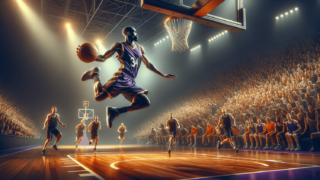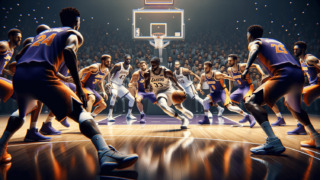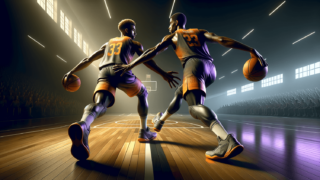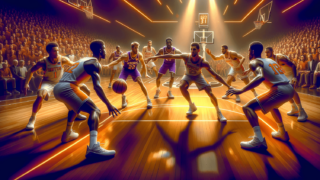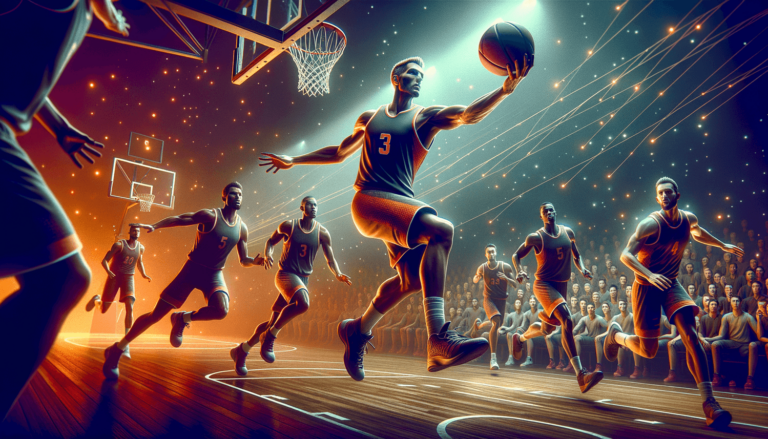
In the exhilarating world of basketball, the simple yet highly effective ‘Give and Go’ play is an excellent example of teamwork and tactics merging seamlessly. Regardless of your experience with the sport, learning more about this classic move can only enhance your appreciation for the game. So grab your favorite chair, sit down, and get ready for a fun and professional dive into this age-old strategy, where we uncover the intricacies, variations, and potential challenges of the ‘Give and Go’!
What’s a Give and Go Play in Basketball?
A ‘Give and Go’ play in basketball is a fundamental offensive strategy where a player passes the ball to a teammate and quickly moves towards the basket, looking to receive the ball back for a scoring opportunity. It relies on timing, spacing, and cooperation, often catching defenders off-guard and creating open shots or layups.
Anatomy of a Successful Give and Go Play
Before we delve deeper into the various aspects of the Give and Go play, it’s essential to understand its basic structure. A well-executed Give and Go consists of three primary components: the passer, the cutter, and often, the off-ball movement of surrounding teammates. These elements lead to a successful play by putting pressure on the defense, creating open space, and ultimately yielding scoring opportunities. So, let’s break down these components and analyze how their synergy forms the backbone of the Give and Go in the wonderful world of basketball.
The Passer
The player initiating the play with the pass must be quick, precise, and aware of the teammates’ movements when executing the Give and Go. Timing is crucial here, and the passer should remain unselfish to create an assist opportunity. Remember, it’s essential to make a crisp and accurate pass, enabling the cutter to receive the ball in an advantageous position.
The Cutter
The heart of the Give and Go lies in the hands of the cutter. This player’s primary responsibility is to make a sharp, well-timed cut towards the basket after passing the ball, ready to receive it back from the teammate. This move is executed to exploit the split-second reaction deficiency of the defender, made possible through precise footwork, quick bursts of speed, and efficient use of open space on the court.
Off-Ball Movement of Teammates
In a Give and Go, the remaining players on the court play crucial roles in creating opportunities for scoring by engaging in off-ball movements. By continuously moving, setting screens, or spreading the floor, teammates can open up space for the cutter to make an effective cut and provide the passer with clear passing lanes to complete the play.
Mastering the Give and Go: Tips and Techniques
The ability to execute a successful Give and Go doesn’t happen overnight; it requires practice and perfecting various elements essential to the play. Here, we’ll explore some valuable tips designed to improve your understanding and execution of this classic move on the basketball court.
Proper Spacing
Ensuring there’s enough space between teammates is an essential aspect of the Give and Go. Proper spacing ensures that defenders can’t easily collapse or provide help defense, allowing the cutting player to move more freely towards the basket.
Set a Pseudo Ball-Screen
Before executing the Give and Go, the cutter can attempt to set a pseudo ball-screen for their teammate. By doing this, the cutter can create uncertainty in the defender’s mind while gaining leverage, ultimately amplifying the success rate of the play.
Communicate and Be Decisive
Communication, both verbal and non-verbal, is vital for synchronizing effectively with teammates during any play, especially the Give and Go. Be deliberate with your actions, make it clear when you’re about to initiate the play, and use visual cues like eye contact to inform your teammates when you’re ready to cut.
Keep the Defense Guessing
A successful Give and Go often comes down to misdirection and exploiting the defender’s focus. Mix up your playstyle by occasionally making counter-moves, setting up screens, or repositioning yourself before cutting to the basket to keep the defense guessing.
Give and Go Variations: Expanding your Offensive Toolbox
Though the core concept of the Give and Go has remained largely unchanged since its inception, several variations have emerged over time. Here, we’ll discuss some popular adaptations of the classic Give and Go, allowing you to expand your offensive repertoire on the basketball court.
Backdoor Give and Go
A deceptive twist on the traditional Give and Go, the Backdoor Give and Go involves a player making a hard cut towards the basket after passing the ball. To set up this play, the cutter fakes a move towards the ball, forcing their defender to overcommit, then abruptly cuts back towards the basket. This technique creates separation from the defender, providing an open scoring opportunity with a well-timed pass.
High Post Give and Go
The High Post Give and Go takes advantage of the space near the free-throw line, where the cutting player can pass the ball to a teammate situated at the high post. The off-ball movement by the remaining players and effective screens combine to create the necessary space for a straightforward cut to the basket.
Two-Man Game Give and Go
An extension of the traditional Give and Go, the Two-Man Game involves two players working together in a repetitive manner to exploit openings in the defense. After a player passes to their teammate, they cut to the basket or circle around to receive the ball back. This method can be especially useful in a pick-and-roll or pick-and-pop scenario, constantly putting the defense on its heels.
Dribble Handoff Give and Go
The Dribble Handoff Give and Go combines the fundamentals of the classic play with a dribble handoff. The passer, while holding the ball, facilitates a handoff exchange with the cutter who is quickly dribbling towards them. After exchanging the ball, the cutter then drives towards the basket, while the passer moves towards an open space on the court, ready for a potential return pass.
Defending Against the Give and Go: Tactics and Strategies
While our primary focus has been on the offensive utilization of the Give and Go, knowing how to defend against this play is equally vital in the game of basketball. Here, we provide an overview of defensive strategies to mitigate the effectiveness of the Give and Go, ensuring you’re prepared on both sides of the court.
Read the Play and Anticipate the Cut
Defenders must remain aware of their surroundings and retain their focus when faced with a potential Give and Go. Identifying the play as it unfolds enables the defender to anticipate the cutter’s movement, react quickly, and maintain a tight coverage.
Communicate with Teammates
Team communication can be a game-changer when defending against the Give and Go. Alert your teammates to the possibility of the play or request help defense if caught off-guard by a sudden cut. Synchronized teamwork can disrupt the offensive flow and hinder the passer’s ability to reconnect with the cutter.
Positioning and Footwork
Proper defensive positioning and effective footwork are instrumental during a Give and Go situation. To keep themselves between their opponent and the basket, defenders must maintain an athletic stance while staying light on their feet. Moreover, they should be ready to close the passing lanes or contest shots provided the play develops successfully.
Give and Go in Modern Basketball: An Evolving Legacy
As the game of basketball has evolved, the significance of the Give and Go has transitioned, too. The play has become less prevalent in modern professional leagues, such as the NBA, where the focus on individual talent and isolation plays has grown. However, it remains a powerful tool, particularly for youth and amateur players who value strong teamwork and fundamentals.
By understanding the intricacies of this classic offensive move and incorporating its various adaptations into your game, you’ll have the upper hand on the court. No matter your skill level or experience, the timeless Give and Go play remains a symbol of quick-wittedness, agility, and teamwork in the dynamic game of basketball.
Combining the Give and Go with Other Basketball Strategies
While the Give and Go play is versatile and effective in isolation, it can be further enhanced when combined with other basketball strategies. By incorporating these tactics, you can create more dynamic offensive options to keep the defense on its toes. Here, we explore several fundamental basketball strategies that can work seamlessly with the Give and Go play.
Utilizing the Pick and Roll
The iconic Pick and Roll strategy can be effectively used in conjunction with the Give and Go. In this situation, a teammate sets a screen for the dribbler, who then passes the ball to a player on the wing. The dribbler makes a quick cut towards the basket, looking for the screen-setter to release the ball back. This combination is great for disrupting the defense and getting ahead of your opponent.
Incorporating Motion Offense Principles
Integrating motion offense principles like constant player movement, floor spacing, and sharp passing into the Give and Go can create a less predictable offensive approach. By relocating consistently, cutting decisively, and capitalizing on momentary defensive lapses, your team can exploit mismatches and carve out new scoring opportunities with the Give and Go tactic.
Fast Break Give and Go
In transition or fast-break scenarios, the Give and Go can be a valuable weapon. As teammates sprint down the court, the ball-handler can quickly pass to a teammate and cut towards the basket. With good timing and communication, this accelerated version of the Give and Go can lead to easy layups or uncontested shots while catching the defense off guard.
Implementing the Give and Go in Basketball Drills
Practicing the Give and Go in basketball drills is crucial for ingraining this tactic in your muscle memory and developing strong habits on the court. Here, we offer some functional practice drills that can help players build their familiarity with the Give and Go and improve various aspects of the play.
Three-Man Give and Go Drill
This drill involves three players forming a triangle around the basket. The player with the ball passes to either of the two other players and makes a strong cut towards the hoop, receiving a return pass for a layup. After passing, the next player does the same with the third player. This continuous, rotations-based drill helps players enhance their timing, passing accuracy, and cutting speed.
Two-on-Two Give and Go Drill
A Two-on-Two Give and Go drill replicates game-like situations by incorporating defenders. With two offensive players and two defenders, one offensive player initiates the Give and Go play while the defender attempts to prevent the pass and cut. This interactive drill helps develop communication, decision making, and proper execution under pressure.
Four-Corner Give and Go Drill
The four-corner drill focuses on spacing, timing, and activation from various spots on the basketball court. With players set up at each corner, the player with the ball initiates a Give and Go play with the teammate closest to them in a diagonal fashion. As players pass, cut, and shoot, they rotate to another corner, ensuring exposure to different court positions and angles.
By incorporating the Give and Go play with additional basketball strategies and engaging in practice drills, players and teams can sharpen their skills, develop innovative offensive tactics, and cultivate a strong foundation in the game of basketball.
Frequently Asked Questions
As an essential basketball offensive move, the Give and Go can lead to many questions regarding its execution, benefits, and applications. We’ve compiled a list of common questions and short answers to provide further insight and help you broaden your understanding of this classic play.
What is the primary advantage of the Give and Go?
The main advantage of the Give and Go is its ability to exploit defensive lapses, create open shots or layups, and promote teamwork through precise passing and coordinated movement.
What makes the Give and Go play effective?
The effectiveness of the Give and Go lies in its simplicity, speed, and reliance on proper timing, footwork, and anticipation of both the passer and the cutter.
Can beginners effectively utilize the Give and Go play?
Yes, the Give and Go is considered a fundamental basketball tactic that can be easily learned and executed by players at all skill levels, including beginners.
How important is communication during a Give and Go?
Communication, both verbal and non-verbal, is crucial in successfully coordinating and executing the Give and Go play with your teammates.
Can the Give and Go still be effective in a slow-paced game?
While the Give and Go is typically employed during fast-paced games, with correct timing and efficient execution, it can still be an effective offensive tool in a slow-paced game.
What can I do as a defender to counter a Give and Go?
To counter a Give and Go, anticipate the cutter’s movement, maintain proper defensive positioning, communicate with your teammates for help defense, and disrupt passing lanes when possible.
Why are spacing and off-ball movement important during a Give and Go?
Proper spacing and off-ball movement are important because they create open space on the court, draw defensive attention away from the cutter, and facilitate a clear passing lane for the return pass.
Can the Give and Go be combined with other basketball plays?
Yes, combining the Give and Go with other basketball strategies like the Pick and Roll, Motion Offense, and Fast Break can create dynamic and unpredictable offensive options.
How can I practice the Give and Go alone?
While practicing with teammates is ideal, you can improve your individual skills related to the Give and Go by focusing on agility, footwork, and precise passing using a wall or passer device as a makeshift teammate.
Is the Give and Go less prevalent in professional leagues?
Though the Give and Go has seen reduced usage in modern professional leagues, such as the NBA, it remains a powerful offensive weapon and a symbol of teamwork and solid fundamentals, especially on the youth and amateur levels.
Featured Posts
- No pillar pages found.
